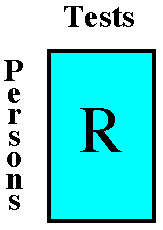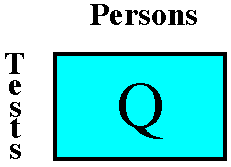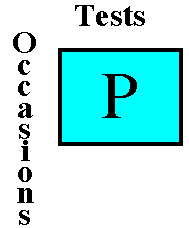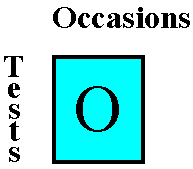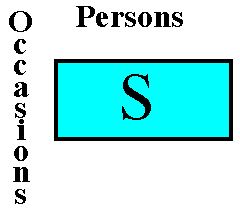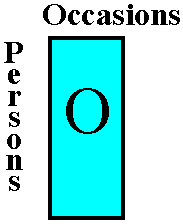Multivariate Analysis
Exploratory Factor Analysis
Factor Analysis Model
Z = FA' [1]
That is,
zj = aj1F1 + aj2F2 +...+ ajpFp
where
Z -> (nxm) standard score matrix
A -> (mxp) factor pattern matrix
F -> (nxp) factor score matrix
Factor Pattern
The factor pattern matrix, A, is the matrix of coefficients which applied to the factor
scores reproduces the standard score matrix.
Factor Structure
S = Z'F/n = A(F'F/n) [2]
S -> (mxp) factor structure matrix
The factor structure matrix, S, is the matrix of correlations between factors and variables. Sometimes
called the loading matrix. With orthogonal solutions the structure matrix and pattern matrix are
the same.
Factor Correlations
Φ = F'F/n [3]
Φ -> (pxp) factor correlation matrix
If the factor analysis solution is orthogonal then Φ = I.
Fun with Math
Substituting into [2]
S = Z'F/n = A(F'F/n) [2]
we get
S = Z'F/n = A(F'F/n) = AΦ [4]
thus, when Φ = I, S = AI or S = A.
Reproduced Correlations
A = SΦ-1
Since R = Z'Z/n [5]
Rr = AF'FA'/n = A(F'F/n)A' = AΦA'
Rr -> (mxm) matrix of reproduced correlations
Or equivalently, Rr = SA'
Variance to be Factored
Total variance = hj2 + bj2 + ej2
Reliability = hj2 + bj2
Communality hj2 = hj2
Uniqueness dj2 = bj2 + ej2
Specificity bj2 = bj2
Error ej2 = ej2
PCA vs FA
Principal Components Analysis analyzes the total variance. That is, it analyzes the correlation matrix
with one's in the diagonal.
Factor Analysis analyzes the common variance. Analyzes the correlation matrix with communality
estimates in the diagonal. Sometimes called common factor analysis.
The Concept of Simple Structure
Each row in the factor pattern matrix should contain at least one zero.
Each column of the factor pattern matrix should contain at least m zeros.
Every pair of columns should contain rows whose loadings are zero in one column but
non-zero in the other.
Every pair of columns should contain a large rows whose loadings are zero in both columns.
Every pair of columns should have only a few non-zero loadings in both columns.
Simple Structure Example
Initial Rotated
Solution Solution
I II III F1 F2 F3
var1 X X 0 0 0 X
var2 X X 0 0 0 X
var3 X X 0 0 0 X
var4 X -X 0 0 X 0
var5 X -X 0 0 X 0
var6 X 0 X X 0 0
var7 X 0 -X X 0 0
var8 X 0 -X X 0 0
G B B P P P
Decisions in Factor Analysis
- Method of initial factor solution
- Method communality estimation
- Number of factors to retain
- Method of rotation
Method of Initial Factor Solution
- Principal Axis Factor Analysis
- Iterated Principal Axis Factor Analysis*
- Image Factor Analysis
- Alpha Factor Analysis
- Maximum Likelihood Factor Analysis*
- Unweighted Least Squares Factor Analysis
- Generalized Least Squares Factor Analysis
Estimation of Communalities
- SMC's*
- Reliabilities
- Largest off diagonal
- Average Correlations
- Centroid
- Averoid
Number of Factors to Retain
- Number of Eigenvalues greater than or equal to one (from the unreduced correlation matrix)
- Scree Test/Scree Plot
- Percent of variance
- Hypothesis testing (ML)
- Parallel analysis -- Monte Carlo (Humphreys & Ilgen, 1959; Montanelli & Humphreys, 1976)
- Linn Method -- Monte Carlo (Linn, 1968)
- Ender Method -- Quasi-Monte Carlo
Scree Plot

Methods of Rotation
Orthogonal Rotations
- Varimax*
- Varimax via the GPF algorithm*
- Quartimax
- Orthomax
- Equamax
- Parsimax
- Minimum entropy
- Comrey's tandem 1
- Comrey's tandem 2
Oblique Rotations
- Promax
- Oblimin*
- Oblimax
- Quartimin
- Biquartimin
- Crawford-Ferguson*
- Bentler's invariant pattern simplicity
- Binormamin
- Maxplane
Rotating Example
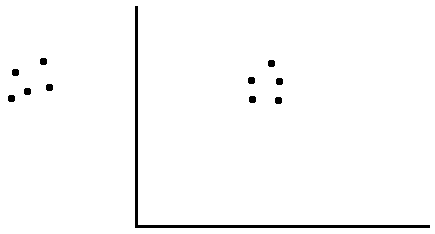
Unrotated Factor Solution
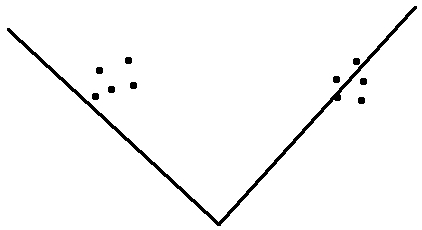
Orthogonal Factor Solution
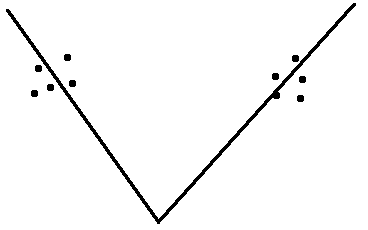
Oblique Factor Solution
The following example uses data for five socio-economic variables for 12 different locations.
the variables are total population, median schooling, total employed, misc. professional services,
and median housing value. The data are from Harman (1976).
Sample Size for Factor Analysis
There are a number of different guidelines given in the literature as to the appropriate sample
size needed for factor analysis. I was taught that you needed at least 10 times as many observations
as variables with a minimum of 200 observations. Pedhazur & Schmelkin (1991) suggest at least
50 observations per factor. Guadagnoli and Velicer (1988) have suggested a
minimum sample size of 100 to 200 observations. Tabachnick & Fidell (1996) recommend at
least 300 cases. And Comrey and Lee (1992) give the following guide for samples sizes:
50 as very poor, 100 as poor, 200 as fair, 300 as good, 500 as very good, and 1,000 as excellent.
Just remember, as with all statistical rules of thumb, your milage may vary.
Principal Axis Factor Analysis
use http://www.gseis.ucla.edu/courses/data/harman1, clear
factor pop medsch employ profser medhouse, pf fac(2)
(obs=12)
(principal factors; 2 factors retained)
Factor Eigenvalue Difference Proportion Cumulative
------------------------------------------------------------------
1 2.73430 1.01823 0.6225 0.6225
2 1.71607 1.67651 0.3907 1.0131
3 0.03956 0.06409 0.0090 1.0221
4 -0.02452 0.04808 -0.0056 1.0165
5 -0.07261 . -0.0165 1.0000
Factor Loadings
Variable | 1 2 Uniqueness
----------+--------------------------------
pop | 0.62533 0.76621 0.02189
medsch | 0.71370 -0.55515 0.18244
employ | 0.71447 0.67936 0.02800
profser | 0.87899 -0.15846 0.20226
medhouse | 0.74215 -0.57806 0.11505
mat psi = e(Psi)'
mat com = J(rowsof(psi),1,1)
mat com = com - psi
mat colnames com=communalities
mat list com
com[5,1]
communalities
pop .97811334
medsch .81756393
employ .97199928
profser .79774303
medhouse .88495002
rotate, varimax normalize
Factor analysis/correlation Number of obs = 12
Method: principal factors Retained factors = 2
Rotation: orthogonal varimax (Kaiser on) Number of params = 9
--------------------------------------------------------------------------
Factor | Variance Difference Proportion Cumulative
-------------+------------------------------------------------------------
Factor1 | 2.34986 0.24934 0.5349 0.5349
Factor2 | 2.10051 . 0.4782 1.0131
--------------------------------------------------------------------------
LR test: independent vs. saturated: chi2(10) = 60.63 Prob>chi2 = 0.0000
Rotated factor loadings (pattern matrix) and unique variances
-------------------------------------------------
Variable | Factor1 Factor2 | Uniqueness
-------------+--------------------+--------------
pop | 0.0225 0.9887 | 0.0219
medsch | 0.9042 0.0006 | 0.1824
employ | 0.1462 0.9750 | 0.0280
profser | 0.7909 0.4151 | 0.2023
medhouse | 0.9407 -0.0000 | 0.1150
-------------------------------------------------
Factor rotation matrix
--------------------------------
| Factor1 Factor2
-------------+------------------
Factor1 | 0.7889 0.6145
Factor2 | -0.6145 0.7889
--------------------------------
rotate, oblique quartimin normalize
Factor analysis/correlation Number of obs = 12
Method: principal factors Retained factors = 2
Rotation: oblique quartimin (Kaiser on) Number of params = 9
--------------------------------------------------------------------------
Factor | Variance Proportion Rotated factors are correlated
-------------+------------------------------------------------------------
Factor1 | 2.44531 0.5567
Factor2 | 2.19402 0.4995
--------------------------------------------------------------------------
LR test: independent vs. saturated: chi2(10) = 60.63 Prob>chi2 = 0.0000
Rotated factor loadings (pattern matrix) and unique variances
-------------------------------------------------
Variable | Factor1 Factor2 | Uniqueness
-------------+--------------------+--------------
pop | -0.0708 1.0001 | 0.0219
medsch | 0.9172 -0.0913 | 0.1824
employ | 0.0560 0.9736 | 0.0280
profser | 0.7630 0.3405 | 0.2023
medhouse | 0.9544 -0.0956 | 0.1150
-------------------------------------------------
Factor rotation matrix
--------------------------------
| Factor1 Factor2
-------------+------------------
Factor1 | 0.8463 0.6851
Factor2 | -0.5327 0.7284
--------------------------------
estat common
Correlation matrix of the Crawford-Ferguson(0) rotated common factors
----------------------------------
Factors | Factor1 Factor2
-------------+--------------------
Factor1 | 1
Factor2 | .1917 1
----------------------------------
Remember, with oblique rotations you can get loadings greater than one.
Iterated Principal Axis Factor Analysis
factor pop medsch employ profser medhouse, ipf fac(2)
(obs=12)
Factor analysis/correlation Number of obs = 12
Method: iterated principal factors Retained factors = 2
Rotation: (unrotated) Number of params = 9
Beware: solution is a Heywood case
(i.e., invalid or boundary values of uniqueness)
--------------------------------------------------------------------------
Factor | Eigenvalue Difference Proportion Cumulative
-------------+------------------------------------------------------------
Factor1 | 2.75653 1.01187 0.6124 0.6124
Factor2 | 1.74466 1.71387 0.3876 1.0000
Factor3 | 0.03079 0.03118 0.0068 1.0068
Factor4 | -0.00039 0.03002 -0.0001 1.0068
Factor5 | -0.03041 . -0.0068 1.0000
--------------------------------------------------------------------------
LR test: independent vs. saturated: chi2(10) = 60.63 Prob>chi2 = 0.0000
Factor loadings (pattern matrix) and unique variances
-------------------------------------------------
Variable | Factor1 Factor2 | Uniqueness
-------------+--------------------+--------------
pop | 0.6300 0.7945 | -0.0282
medsch | 0.7006 -0.5241 | 0.2344
employ | 0.6973 0.6710 | 0.0635
profser | 0.8808 -0.1470 | 0.2026
medhouse | 0.7789 -0.6057 | 0.0264
-------------------------------------------------
mat psi = e(Psi)'
mat com = J(rowsof(psi),1,1)
mat com = com - psi
mat colnames com=communalities
mat list com
com[5,1]
communalities
pop 1.0281865
medsch .76556374
employ .93651122
profser .7973836
medhouse .97355023
rotate, varimax normalize
Factor analysis/correlation Number of obs = 12
Method: iterated principal factors Retained factors = 2
Rotation: orthogonal varimax (Kaiser on) Number of params = 9
Beware: solution is a Heywood case
(i.e., invalid or boundary values of uniqueness)
--------------------------------------------------------------------------
Factor | Variance Difference Proportion Cumulative
-------------+------------------------------------------------------------
Factor1 | 2.38417 0.26714 0.5297 0.5297
Factor2 | 2.11703 . 0.4703 1.0000
--------------------------------------------------------------------------
LR test: independent vs. saturated: chi2(10) = 60.63 Prob>chi2 = 0.0000
Rotated factor loadings (pattern matrix) and unique variances
-------------------------------------------------
Variable | Factor1 Factor2 | Uniqueness
-------------+--------------------+--------------
pop | 0.0189 1.0138 | -0.0282
medsch | 0.8749 0.0084 | 0.2344
employ | 0.1473 0.9565 | 0.0635
profser | 0.7894 0.4174 | 0.2026
medhouse | 0.9866 -0.0090 | 0.0264
-------------------------------------------------
Factor rotation matrix
--------------------------------
| Factor1 Factor2
-------------+------------------
Factor1 | 0.7950 0.6066
Factor2 | -0.6066 0.7950
--------------------------------
rotate, oblique quartimin normalize
Factor analysis/correlation Number of obs = 12
Method: iterated principal factors Retained factors = 2
Rotation: oblique quartimin (Kaiser on) Number of params = 9
Beware: solution is a Heywood case
(i.e., invalid or boundary values of uniqueness)
--------------------------------------------------------------------------
Factor | Variance Proportion Rotated factors are correlated
-------------+------------------------------------------------------------
Factor1 | 2.47827 0.5506
Factor2 | 2.20947 0.4909
--------------------------------------------------------------------------
LR test: independent vs. saturated: chi2(10) = 60.63 Prob>chi2 = 0.0000
Rotated factor loadings (pattern matrix) and unique variances
-------------------------------------------------
Variable | Factor1 Factor2 | Uniqueness
-------------+--------------------+--------------
pop | -0.0767 1.0259 | -0.0282
medsch | 0.8868 -0.0803 | 0.2344
employ | 0.0590 0.9547 | 0.0635
profser | 0.7614 0.3430 | 0.2026
medhouse | 1.0018 -0.1093 | 0.0264
-------------------------------------------------
Factor rotation matrix
--------------------------------
| Factor1 Factor2
-------------+------------------
Factor1 | 0.8515 0.6778
Factor2 | -0.5244 0.7353
--------------------------------
estat common
Correlation matrix of the quartimin rotated common factors
----------------------------------
Factors | Factor1 Factor2
-------------+--------------------
Factor1 | 1
Factor2 | .1915 1
----------------------------------
Maximum Likelihood Factor Analysis
factor pop medsch employ profser medhouse, ml fac(2)
(obs=12)
Factor analysis/correlation Number of obs = 12
Method: maximum likelihood Retained factors = 2
Rotation: (unrotated) Number of params = 9
Schwarz's BIC = 26.0449
Log likelihood = -1.84039 (Akaike's) AIC = 21.6808
Beware: solution is a Heywood case
(i.e., invalid or boundary values of uniqueness)
--------------------------------------------------------------------------
Factor | Eigenvalue Difference Proportion Cumulative
-------------+------------------------------------------------------------
Factor1 | 2.13887 -0.22952 0.4745 0.4745
Factor2 | 2.36839 . 0.5255 1.0000
--------------------------------------------------------------------------
LR test: independent vs. saturated: chi2(10) = 60.63 Prob>chi2 = 0.0000
LR test: 2 factors vs. saturated: chi2(1) = 2.50 Prob>chi2 = 0.1135
(tests formally not valid because a Heywood case was encountered)
Factor loadings (pattern matrix) and unique variances
-------------------------------------------------
Variable | Factor1 Factor2 | Uniqueness
-------------+--------------------+--------------
pop | 1.0000 -0.0000 | 0.0000
medsch | 0.0098 0.9000 | 0.1900
employ | 0.9725 0.1179 | 0.0404
profser | 0.4389 0.7892 | 0.1844
medhouse | 0.0224 0.9600 | 0.0779
-------------------------------------------------
faform /* Available from ATS via the Internet */
Factor Loadings in Canonical Form
1 2
pop 0.62151 0.78340
medsch 0.71109 -0.55170
employ 0.69679 0.68853
profser 0.89106 -0.14672
medhouse 0.76602 -0.57911
mat psi = e(Psi)'
mat com = J(rowsof(psi),1,1)
mat com = com - psi
mat colnames com=communalities
mat list com
com[5,1]
communalities
pop .99999969
medsch .81003767
employ .95956448
profser .81555395
medhouse .92206406
rotate, varimax normalize
Factor analysis/correlation Number of obs = 12
Method: maximum likelihood Retained factors = 2
Rotation: orthogonal varimax (Kaiser on) Number of params = 9
Schwarz's BIC = 26.0449
Log likelihood = -1.84039 (Akaike's) AIC = 21.6808
Beware: solution is a Heywood case
(i.e., invalid or boundary values of uniqueness)
--------------------------------------------------------------------------
Factor | Variance Difference Proportion Cumulative
-------------+------------------------------------------------------------
Factor1 | 2.38926 0.27125 0.5301 0.5301
Factor2 | 2.11801 . 0.4699 1.0000
--------------------------------------------------------------------------
LR test: independent vs. saturated: chi2(10) = 60.63 Prob>chi2 = 0.0000
LR test: 2 factors vs. saturated: chi2(1) = 2.50 Prob>chi2 = 0.1135
(tests formally not valid because a Heywood case was encountered)
Rotated factor loadings (pattern matrix) and unique variances
-------------------------------------------------
Variable | Factor1 Factor2 | Uniqueness
-------------+--------------------+--------------
pop | 0.0213 0.9998 | 0.0000
medsch | 0.9000 -0.0095 | 0.1900
employ | 0.1387 0.9697 | 0.0404
profser | 0.7984 0.4219 | 0.1844
medhouse | 0.9603 0.0019 | 0.0779
-------------------------------------------------
Factor rotation matrix
--------------------------------
| Factor1 Factor2
-------------+------------------
Factor1 | 0.0213
Factor2 | 0.9998 -0.0213
--------------------------------
rotate, oblique quartimin normalize
Factor analysis/correlation Number of obs = 12
Method: maximum likelihood Retained factors = 2
Rotation: oblique quartimin (Kaiser on) Number of params = 9
Schwarz's BIC = 26.0449
Log likelihood = -1.84039 (Akaike's) AIC = 21.6808
Beware: solution is a Heywood case
(i.e., invalid or boundary values of uniqueness)
--------------------------------------------------------------------------
Factor | Variance Proportion Rotated factors are correlated
-------------+------------------------------------------------------------
Factor1 | 2.48025 0.5503
Factor2 | 2.20740 0.4897
--------------------------------------------------------------------------
LR test: independent vs. saturated: chi2(10) = 60.63 Prob>chi2 = 0.0000
LR test: 2 factors vs. saturated: chi2(1) = 2.50 Prob>chi2 = 0.1135
(tests formally not valid because a Heywood case was encountered)
Rotated factor loadings (pattern matrix) and unique variances
-------------------------------------------------
Variable | Factor1 Factor2 | Uniqueness
-------------+--------------------+--------------
pop | -0.0700 1.0106 | 0.0000
medsch | 0.9131 -0.0981 | 0.1900
employ | 0.0517 0.9687 | 0.0404
profser | 0.7706 0.3488 | 0.1844
medhouse | 0.9732 -0.0925 | 0.0779
-------------------------------------------------
Factor rotation matrix
--------------------------------
| Factor1 Factor2
-------------+------------------
Factor1 | 0.1179 0.9976
Factor2 | 0.9930 0.0688
--------------------------------
estat common
Correlation matrix of the quartimin rotated common factors
----------------------------------
Factors | Factor1 Factor2
-------------+--------------------
Factor1 | 1
Factor2 | .1859 1
----------------------------------
How to Do It
Create reduced correlation matrix, R1, by replacing the diagonal elements of
the correleation matrix with SMC's
SMC's are obtained as follows:
where each rjj is a diagonal element of R-1.
Now do the same as in Principal Components Analysis using R1 instead of R.
Factor Scores
In common-factor analysis the scores on the common factors are estimated rather
than determined from the scores on the observed variables.
It is mathematically impossible to determine uniquely or exactly the common-factor
scores even if the population correlations are known.
This is know as factor indeterminacy.
Factor score estimation is done by a variation of the multiple regression procedure.
where
Z -> Standard scores
A -> Factor pattern matrix
Rzz -> Correlations among the variables
Rxx -> Correlation among the factors
Types of Factor Analysis
R Factor Analysis
Q Factor Analysis
P Factor Analysis
O Factor Analysis
S Factor Analysis
T Factor Analysis
Stata Example
Here is an example using the api99g dataset.
use http://www.gseis.ucla.edu/courses/data/api99g, clear
keep if stype==1 /* use only elementary schools */
(1773 observations deleted)
summarize meals ell yr_rnd acs_k3 acs_46 avg_ed full enroll
Variable | Obs Mean Std. Dev. Min Max
-------------+-----------------------------------------------------
meals | 4421 51.88102 31.07313 0 100
ell | 4421 25.19204 22.91157 0 95
yr_rnd | 4421 1.178919 .3833277 1 2
acs_k3 | 4359 19.29571 1.539583 12 31
acs_46 | 4294 28.90452 3.21889 14 50
avg_ed | 4257 2.749298 .7542556 1 5
full | 4420 87.86357 13.35186 13 100
enroll | 4397 426.9616 175.8747 101 1570
univar meals ell yr_rnd acs_k3 acs_46 avg_ed full enroll
-------------- Quantiles --------------
Variable n Mean S.D. Min .25 Mdn .75 Max
-------------------------------------------------------------------------------
meals 4421 51.88 31.07 0.00 24.00 53.00 79.00 100.00
ell 4421 25.19 22.91 0.00 6.00 18.00 40.00 95.00
yr_rnd 4421 1.18 0.38 1.00 1.00 1.00 1.00 2.00
acs_k3 4359 19.30 1.54 12.00 19.00 19.00 20.00 31.00
acs_46 4294 28.90 3.22 14.00 27.00 29.00 31.00 50.00
avg_ed 4257 2.75 0.75 1.00 2.17 2.71 3.26 5.00
full 4420 87.86 13.35 13.00 81.00 92.00 100.00 100.00
enroll 4397 426.96 175.87 101.00 303.00 403.00 523.00 1570.00
-------------------------------------------------------------------------------
corr meals ell yr_rnd acs_k3 acs_46 avg_ed full enroll
(obs=4059)
| meals ell yr_rnd acs_k3 acs_46 avg_ed full enroll
-------------+------------------------------------------------------------------------
meals | 1.0000
ell | 0.7716 1.0000
yr_rnd | 0.3027 0.3158 1.0000
acs_k3 | -0.0251 0.0275 0.0016 1.0000
acs_46 | -0.0274 0.0077 0.0522 0.2788 1.0000
avg_ed | -0.8392 -0.6818 -0.2842 -0.0193 0.0288 1.0000
full | -0.5145 -0.5146 -0.2592 0.0344 -0.0304 0.4036 1.0000
enroll | 0.1984 0.3092 0.5125 0.1374 0.2017 -0.1645 -0.2696 1.0000
factor meals ell yr_rnd acs_k3 acs_46 avg_ed full enroll, ml
(obs=4059)
number of factors adjusted to 4
Factor analysis/correlation Number of obs = 4059
Method: maximum likelihood Retained factors = 4
Rotation: (unrotated) Number of params = 26
Schwarz's BIC = 225.553
Log likelihood = -4.763415 (Akaike's) AIC = 61.5268
Beware: solution is a Heywood case
(i.e., invalid or boundary values of uniqueness)
--------------------------------------------------------------------------
Factor | Eigenvalue Difference Proportion Cumulative
-------------+------------------------------------------------------------
Factor1 | 1.55692 -0.93102 0.2975 0.2975
Factor2 | 2.48794 1.53599 0.4754 0.7728
Factor3 | 0.95195 0.71491 0.1819 0.9547
Factor4 | 0.23705 . 0.0453 1.0000
--------------------------------------------------------------------------
LR test: independent vs. saturated: chi2(28) = 1.3e+04 Prob>chi2 = 0.0000
LR test: 4 factors vs. saturated: chi2(2) = 9.51 Prob>chi2 = 0.0086
(tests formally not valid because a Heywood case was encountered)
Factor loadings (pattern matrix) and unique variances
---------------------------------------------------------------------
Variable | Factor1 Factor2 Factor3 Factor4 | Uniqueness
-------------+----------------------------------------+--------------
meals | 0.1984 0.9058 -0.0057 0.1342 | 0.1222
ell | 0.3092 0.7430 0.0226 0.2775 | 0.2749
yr_rnd | 0.5125 0.2211 -0.0618 0.0030 | 0.6846
acs_k3 | 0.1374 -0.0538 0.9340 0.0133 | 0.1058
acs_46 | 0.2017 -0.0780 0.2640 0.0249 | 0.8829
avg_ed | -0.1645 -0.9192 -0.0522 0.1914 | 0.0887
full | -0.2696 -0.4612 0.0540 -0.3234 | 0.6070
enroll | 1.0000 -0.0000 -0.0000 -0.0000 | 0.0000
---------------------------------------------------------------------
/* don't display small loadings */
factor, blanks(.2)
(obs=4059)
Factor analysis/correlation Number of obs = 4059
Method: maximum likelihood Retained factors = 4
Rotation: (unrotated) Number of params = 26
Schwarz's BIC = 225.553
Log likelihood = -4.763415 (Akaike's) AIC = 61.5268
Beware: solution is a Heywood case
(i.e., invalid or boundary values of uniqueness)
--------------------------------------------------------------------------
Factor | Eigenvalue Difference Proportion Cumulative
-------------+------------------------------------------------------------
Factor1 | 1.55692 -0.93102 0.2975 0.2975
Factor2 | 2.48794 1.53599 0.4754 0.7728
Factor3 | 0.95195 0.71491 0.1819 0.9547
Factor4 | 0.23705 . 0.0453 1.0000
--------------------------------------------------------------------------
LR test: independent vs. saturated: chi2(28) = 1.3e+04 Prob>chi2 = 0.0000
LR test: 4 factors vs. saturated: chi2(2) = 9.51 Prob>chi2 = 0.0086
(tests formally not valid because a Heywood case was encountered)
Factor loadings (pattern matrix) and unique variances
---------------------------------------------------------------------
Variable | Factor1 Factor2 Factor3 Factor4 | Uniqueness
-------------+----------------------------------------+--------------
meals | 0.9058 | 0.1222
ell | 0.3092 0.7430 0.2775 | 0.2749
yr_rnd | 0.5125 0.2211 | 0.6846
acs_k3 | 0.9340 | 0.1058
acs_46 | 0.2017 0.2640 | 0.8829
avg_ed | -0.9192 | 0.0887
full | -0.2696 -0.4612 -0.3234 | 0.6070
enroll | 1.0000 | 0.0000
---------------------------------------------------------------------
(blanks represent abs(loading)<.2)
/* parallel analysis for eigenvalues
compare the eigenvalues of the factor analysis
with eigenvalues of randomly generated variables
to assist in determing the number of factors.
*/
fapara, seed(123456789) /* Available from ATS via the Internet */
(obs=4421)
Parallel Analysis for Eigenvalues
Eigen Random Dif
c1 2.8288 0.0646 2.7642
c2 0.7448 0.0407 0.7041
c3 0.3042 0.0257 0.2785
c4 0.0692 0.0202 0.0490
c5 -0.0720 -0.0167 -0.0553
c6 -0.1129 -0.0338 -0.0792
c7 -0.1929 -0.0417 -0.1512
c8 -0.2339 -0.0468 -0.1870
quietly factor meals ell yr_rnd acs_k3 acs_46 avg_ed full enroll, ml fact(3)
rotate, oblique quartimin normalize blanks(.2)
Factor analysis/correlation Number of obs = 4059
Method: maximum likelihood Retained factors = 3
Rotation: oblique quartimin (Kaiser on) Number of params = 21
Schwarz's BIC = 334.796
Log likelihood = -80.15692 (Akaike's) AIC = 202.314
Beware: solution is a Heywood case
(i.e., invalid or boundary values of uniqueness)
--------------------------------------------------------------------------
Factor | Variance Proportion Rotated factors are correlated
-------------+------------------------------------------------------------
Factor1 | 2.81012 0.5623
Factor2 | 1.56721 0.3136
Factor3 | 1.14509 0.2291
--------------------------------------------------------------------------
LR test: independent vs. saturated: chi2(28) = 1.3e+04 Prob>chi2 = 0.0000
LR test: 3 factors vs. saturated: chi2(7) = 160.10 Prob>chi2 = 0.0000
(tests formally not valid because a Heywood case was encountered)
Rotated factor loadings (pattern matrix) and unique variances
-----------------------------------------------------------
Variable | Factor1 Factor2 Factor3 | Uniqueness
-------------+------------------------------+--------------
meals | 0.9941 | 0.0530
ell | 0.7733 | 0.3411
yr_rnd | 0.5045 | 0.6591
acs_k3 | 1.0281 | 0.0000
acs_46 | 0.2684 | 0.8883
avg_ed | -0.8898 | 0.2570
full | -0.4828 | 0.6853
enroll | 0.9353 | 0.1186
-----------------------------------------------------------
(blanks represent abs(loading)<.2)
Factor rotation matrix
-----------------------------------------
| Factor1 Factor2 Factor3
-------------+---------------------------
Factor1 | -0.0156 0.0850 0.9877
Factor2 | 0.9977 0.3905 -0.0347
Factor3 | -0.0664 0.9167 0.1523
-----------------------------------------
predict f1 f2 f3
(regression scoring assumed)
Scoring coefficients (method = regression; based on quartimin rotated factors)
--------------------------------------------
Variable | Factor1 Factor2 Factor3
-------------+------------------------------
meals | 0.75089 0.00327 -0.07235
ell | 0.09436 0.05264 -0.00078
yr_rnd | 0.01758 0.08515 0.01184
acs_k3 | -0.00759 -0.04124 0.96686
acs_46 | -0.00164 0.02344 0.00389
avg_ed | -0.13741 0.00746 0.01452
full | -0.03079 -0.03137 -0.00200
enroll | 0.05156 0.86936 0.13329
--------------------------------------------
corr f1 f2 f3
(obs=4059)
| f1 f2 f3
-------------+---------------------------
f1 | 1.0000
f2 | 0.3453 1.0000
f3 | -0.0588 0.2052 1.0000
The three factors can be interpreted as follows. Factor 1 seems to reflect socioeconomic variables.
Factor 2 appears to be related to the size of the population in the school neighborhoods, while
Factor 3 is concerned with classroom size.
Stata 9 & above allows for the following methods for initial factor extraction:
pf principal-axis factor analysis; the default
pcf principal-components factor analysis
ipf iterated principal-axis factor analysis
ml maximum-likelihood factor analysis
The following options are allowed with the factor command: factors(#) maximum number of factors to be retained
mineigen(#) minimum value of eigenvalues to be retained
citerate(#) communality re-estimation iterations (ipf only)
The factor commands has the following post-estimation procedures: estat anti anti-image correlation and covariance matrices
estat common correlation matrix of the common factors
estat factors AIC and BIC model selection criteria for different numbers of
factors
estat kmo Kaiser-Meyer-Olkin measure of sampling adequacy
estat residuals matrix of correlation residuals
estat rotatecompare compare rotated and unrotated loadings
estat smc squared multiple correlations between each variable and the rest
estat structure correlations between variables and common factors
estat summarize estimation sample summary
loadingplot plot factor loadings
rotate rotate factor loadings
scoreplot plot score variables
screeplot plot eigenvalues
The following factor rotation procedures are available in Stata 9 using the rotate command: varimax varimax (orthogonal only); the default
vgpf varimax via the GPF algorithm (orthogonal only)
quartimax quartimax (orthogonal only)
equamax equamax (orthogonal only)
parsimax parsimax (orthogonal only)
entropy minimum entropy (orthogonal only)
tandem1 Comrey's tandem 1 principle (orthogonal only)
tandem2 Comrey's tandem 2 principle (orthogonal only)
promax[(#)] promax power # (implies oblique); default is promax(3)
oblimin[(#)] oblimin with gamma=#; default is oblimin(0)
cf(#) Crawford-Ferguson family with kappa=#, 0<=#<1
bentler Bentler's invariant pattern simplicity
oblimax oblimax
quartimin quartimin
target(Tg) rotate towards matrix Tg
partial(Tg W) rotate towards matrix Tg, weighted by matrix W
The rotate command has the following options: orthogonal restrict to orthogonal rotations; default, except with promax()
oblique allow oblique rotations
rotation_methods rotation criterion
normalize rotate Horst normalized matrix
horst synonym for normalize
factors(#) rotate # factors or components; default all
components(#) synonym for factors()
Multivariate Course Page
Phil Ender, 16nov05, 15oct05, 29Jan98






